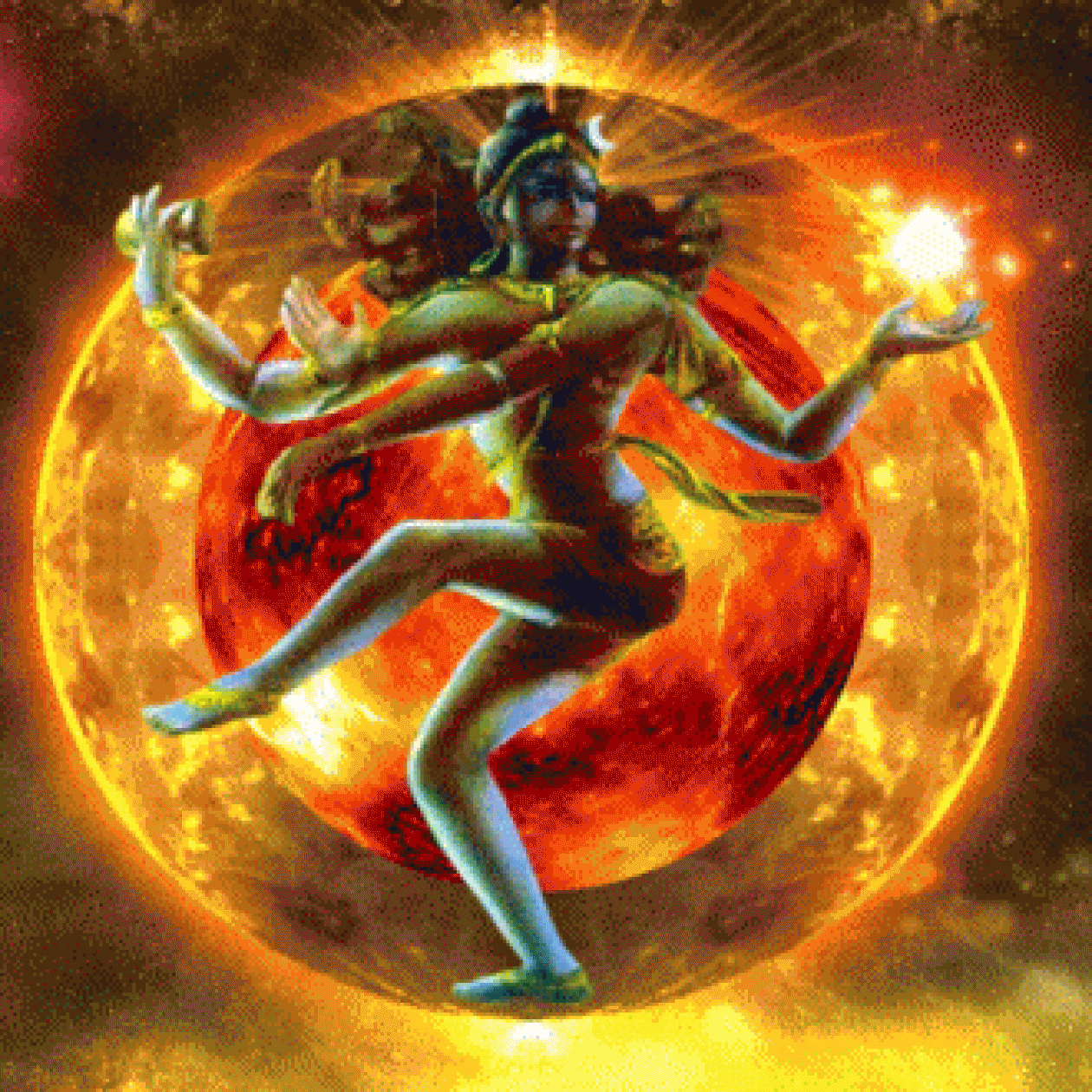SHIVA DANCE
The above verse from Rigveda [7.59.12], known as the Mahamritunjaya or the Death-conquering Mantra is dedicated to Lord Shiv. Ironically, it is Shiva Himself who is revered as the harbinger of the final Destruction of the World!
Who is Shiva? What are the origins of this mighty god in Hindu religion and what are the different facets of His personality? In this post, let us try to analyze this enigmatic god and learn what it means to be the Lord of Destruction..
- Brahma, the First in the Trinity, is the Creator and Master of all Divine Ceremonies.
- Vishnu, the Preserver god who incarnates to help mankind face the challenges posed whenever Evil forces become too dominant in the Universe.
- Shiva, destroys at the End of Time and thus sustains the endless rhythm of the Universe ensuring a continuous cycle of renewal and growth.
In their mistaken belief, some scholars argue that Shiva had a pre-Aryan origin because he was worshiped in the Indus Valley. But, as mentioned in the page {Hindu History} of the blog, the Aryan Civilization, if not earlier, was at the very least contemporary to the Indus-Saraswati Civilization and Vedic scriptures, more likely than not, reflect the literally aspect of the same.
That the Mahabharat follows the Indus perception of Shiva again shows that the two developed same imagery and that this penultimate battle between Good and Evil occurred around the same time as the Indus-Saraswati Civilization! In an article titled {The Riddle of India’s Ancient Past}, the French proto-historian Michel Danino believes there are strong links between Vedas and the Harappan culture.
‘We find statues and seals depicting yogis and yogic postures, we find a Shiva-like deity, worship of a mother-goddess, fire altars, all of which are suggestive of Vedic culture. Harappan symbols include the Trishul, the Swastika, the Conch shell, the Peepal tree, all of which are central to Indian culture. The Rig-Veda itself is full of references to fortified cities and towns, to oceans, sailing, trade and industry, all of which are found in the Harappan civilization.’
The Pashupati seal (2700 BCE) shows a three-headed figure sitting in a Yogic posture surrounded by animals, sometimes with an erect phallus, and more likely than not is an iconic representation of Shiva-Rudra. Exactly similar description arises in the Mahabharat, where the Lord is referred to as Trishira (having three heads); Digvasas (without clothes); Urddh-linga (with upward erect phallus), and Yogadhyaksha, or the Lord of Yoga.
As you probably know from my other posts, I love to find out the similarities between the mythologies from different parts of the world. Keeping up with the tradition, I here share with you the image of the horned god Cernunnos worshiped in Europe around 1st century CE.
Just like Shiva, Cernunnos is believed to be the god of Nature and Fertililty and is still revered in Celtic mythology as the ‘Lord of Animals’ (quite similar to the Indus Pashupati!). Whatever the connection between the two, it is not easy to understand Shiva completely as He is described variously at various places with completely opposite attributes.
In Yajurveda, the contrary attributes are referred to as Rudra, the terrifying and Shiva, the auspicious (Sanskrit Shiv = Shubh). Some scholars believe Rudra to be the older form which was merged later with a ‘Non-Aryan’ god Shiva or Pashupati in later times. But do the scriptures support such a hypothesis?
Rudra, the Destroyer of Creation
The story of Rudra’s birth is very interesting and is identically revealed in many Puranas.
As I had earlier mentioned in the post {Creation by Brahma}, inspite of Brahma’s efforts at populating the world, the early sons of Brahma chose to follow the path of Spirituality instead of procreation and Brahma was sorely disappointed. His first creations, the Sanat Kumars, in fact abhorred entering the Samsar Chakra so much that they continue living the form of 5 year old kids and never attain puberty!
This, however, frustrated Brahma so much that from his forehead, (the region of the third eye) emerged a dark red/blue child bawling at the top of his voice. This angry baby was named Rudra (The Howler)!
Thus, we see, that the scriptures find NO difference between Rudra and Shiva except that the first term encompasses eleven gods, the First and Foremost of whom is Lord Shiv. Therefore, the hypothesis that Shiva was a non-Aryan god who was merged with Rudra is baseless.
The union of Shiva and Shakti is represented symbolically in the form of the Lingam and the Yoni. It symbolizes Hieros-gamos or the ‘Sacred Union’ between God and the Goddess that gives birth to creation. It is yet another tribute to the ancient Indians’ acceptance of the sexual act as a natural phenomenon and one that needs to be worshiped and not abhorred.
The same union is celebrated in Tibetan Tantrism where it is referred to as Yab-Yum (Father-Mother). Shiva is depicted here as Yamantaka or End-of-Yama revealing the episode when He rescued Rishi Markandeya from Yamdev’s noose literally at gun-point (Trident point if you please!).
Mahashivratri is also believed to be the night when Shiva appeared in the form of a Lingam of Fire and challenged the gods Brahma and Vishnu’s contest for supremacy. That was the night Lord Vishnu‘s magnanimity came to fore while Brahma‘s cheating led to Shiva putting the curse that he would never be worshiped.
We see now a reason why Shiva would have invoked belligerence in his father-in-law Daksha Prajapati. After all, Daksha was the eldest Manas-putra of Brahma and could not have taken kindly to this denigration of his father’s position from the Head-of-the-Trinity to its bottom! Perhaps, that was also the reason, that he balked at the idea of his most favored daughter Sati, falling in love with the man he so heartily despised!!
Mahadev’s anger gives birth to Veerbhadra
Virbhadra, born from Shiva’s locks beheads Daksha
This is what makes Shiva more relatable to us humans.. it shows that even at the highest level of spirituality, the bonds of affection may cause a person to slip and plunge into gloom or anger.
Shiva carries the corpse of Sati on His shoulder lamenting His loss till Lord Vishnu uses His Chakra to disintegrate the body. Each part of the body falling on Earth provides a Divine foundation and thus are formed the 51 Shaktipeeths (Seats-of-Energy)!
While both Shiva and Shakti represent the Male and Female forms, their vehicles also represent their innate attributes. Shiva’s vehicle Nandi, the bull, represents magnificence, virility and proud masculinity while Parvati’s vehicle, the mountain Lion or Singh represents her Power or Shakti and the taming of animal instincts by the Mother Goddess.
Archaeologically, we find this reflected in the Zebu bull seals of Indus-Saraswati Civilization (which may represent Nandi) and surprise, surprise, in a far-off valley in Turkey known as Yazili Kaya! The rock-cut friezes in these caves belong to 16th-17th century BCE and show a God Teshav riding a bull, while the accompanying Goddess Hakat rides a Lion and is accompanied by a young boy Kumarbi (Kumar Kartikeya?).
Mount Kailash is believed to be the abode of Shiv and Parvati. There are many mentions of it in the various Puranas and other scriptures like Ramayan and Mahabharat. The mountain is sacred for not only Hindus but also Buddhists, Jains and followers of Bon religion.
Jains worship the region as their First Tirthankar, Rishabhdev attained Nirvana here (Check the post {India and Bharat} for more on Adinath Rishabhdev). Tibetan Buddhists worship Mount Kailash as the home of the Buddha Demchok or Chakrasamvara, who represents supreme bliss.
The followers of Bön religion credit the entire region, especially Kailash, as the seat of all spiritual power. Indeed the area gives one a feeling of entering a more spiritual plane especially when you see mountain peaks like that of the Om Parvat.
Inspite of numerous references to it, the readers might be surprised to know, that Kailash was not always the home of Shiva! Infact, some passages of the Shrimad Bhagvat Puraan state that the original abode of Sadashiv is at the boundary of this Universe at the Loka-aloka border!
These verses in the Vayu Puraan, Chapter 39 shed more light on the details of this place:
This would also make sense, since geologically, the Himalayas (of which Mount Kailash is a part), did not rise up till about 5o million years ago!
Since Hindu Timelines begin close to 155 Trillion years (the present age of Brahma), hence, obviously Lord Shiv would have had to live somewhere else before finally making Kailash His home!! Also, the Himalayas wont stay forever as the Pralaya or the End-of-the-World would destroy the World as we know it and Brahma would then remould it into a new shape.
At that time, Shiva would probably return to the abode known as Manomaya with His family and Kailash may or may not come into being again.
The characteristic of this destruction is that the three worlds (Bhur, Bhuvah and Swarga) continue to exist but are made uninhabitable. The souls of individuals also continue to exist to be reincarnated in the next daytime of Brahma.
The Shiv Purana [2.3.20.14-19] states that the fall off of the energy residing in the THIRD EYE of Shiva fell like lightning and Brahma had to take it to the ocean and keep it under check there else it could burn the entire creation!
The energy thus released was stored underwater in the shape of a mare and is known as the Vadava {Check this link for details – On Wings of Fire}. The fire-mare resides under the ocean (Molten Earth’s core?) and one of the myths calls her wife of Yama and hence a harbinger of Death.
Interestingly, the Pineal gland in Human beings is located at the region of the Third-Eye and has tissue similar to that of the normal functioning eye. Indeed the gland in many vertebrates has cells similar to the photoreceptors of eye used for vision!
Could it then be another vestigial organ that we humans possessed earlier but now has a very limited value?? Lord Shiv, then would be the most ancient progenitor of our race in whom the organ functions as it should!
Swayambhu Manu states alludes to this fire from Shiva’s Eye again stating that in two cases Fire is born out of Water. One, at the time of Lightening and secondly, in the case of the under-water Vadava Mare. Brihadaranyak Upanishad [1.1.2] states that the open mouth of this mare keeps releasing fire in the Sea from time to time, perhaps alluding to submarine eruptions common in the ocean floor!
I conclude this post with the invocation I started the post with as there is nothing better to pray for except getting out of this Samsara Chakra. This Mahashivratri, let us remember the Lord with our hearts and minds and pray for deliverance:
- Om tryambakaṃ yajāmahe sugandhiṃ puṣṭi-vardhanam
- urvārukam iva bandhanān mṛtyormukṣīya māmṛtāt
OM, We worship Shiva, the Three-eyed fragrant Lord, Who nourishes and nurtures all beings, As is the ripened cucumber freed from its bondage (to the creeper), May He liberate us from Death and take us to Immortality.








Heya i am for the primary time here. I found this board and I in
finding It truly useful & it helped me out much.
I am hoping to provide something again and aid others such
as you helped me.
LikeLike
yes add please.
LikeLike
This is the right site for anybody who would like to find out about this topic.
You realize so much its almost tough to argue with you (not that I actually would want to…HaHa).
You definitely put a brand new spin on a topic which has been written about for decades.
Wonderful stuff, just excellent!
LikeLike
Thank you very much.
LikeLike
Approach people on the Top Reviewers list on Amazon, some will agree to give you a review,
some won’t but their reviews are fair and respected.
Many accept applications for online tutors, with variable rates and topic areas.
Thanks to the advancement of technology advances,
the world at present is brimming with gadgets.
What you need to do to sell your e-book in the Amazon Kindle store :.
In many of the excerpts, I was very much impressed with how much character development was possible
in so few pages.
LikeLike
Nice post. I used to be checking continuously this weblog and
I’m inspired! Very helpful information particularly the last phase :
) I care for such info a lot. I was looking for this certain info for a long time.
Thanks and good luck.
LikeLike
Super-Duper site! I am loving it!! Will come back again.
I am taking your feeds also.
LikeLike
Appreciation to my father who informed me on the topic of this web site,
this weblog is truly awesome.
LikeLike
What’s up, yes this article is really good and I have learned lot
of things from it on the topic of blogging.
thanks.
LikeLike
Good day! This is my first visit to your blog! We are a
collection of volunteers and starting a new project in a community in the same niche.
Your blog provided us valuable information to work
on. You have done a marvellous job!
LikeLike
Thank you very much .Just mention name in your project please and also this website. I will keep bringing new coding for Hinduism,sanatan dharm.
LikeLike
Hi colleagues, its great paragraph on the topic of tutoringand entirely explained,
keep it up all the time.
LikeLike
Hey! I understand this is somewhat off-topic however I had
to ask. Does managing a well-established blog such as yours
require a lot of work? I’m brand new to writing a blog but I do write in my diary daily.
I’d like to start a blog so I can share my experience and thoughts online.
Please let me know if you have any suggestions or tips for new aspiring bloggers.
Appreciate it!
LikeLike
Just write one a day
LikeLike
eternity warriors 3 hack includes a big purpose with U .
s . Way of life. Many people is usually noticed involved
in things to do linked to eternity warriors 3 cheats.
This can be partially since folks on most age range could be concerned and also people usually are delivered together simply by
this particular. Typically anyone exactly who displays his
or her dislike with regard to eternity warriors
3 hack android may be regarded as a great outcast.
LikeLike
Hi my family member! I wish to say that this article is
awesome, great written and include almost all vital infos.
I’d like to see more posts like this .
LikeLike
My spouse and I stumbled over here from a different website and thought I might as well check
things out. I like what I see so now i’m following you.
Look forward to checking out your web page yet again.
LikeLike
Thank u very much
LikeLike
Right now it looks like BlogEngine is the best blogging
platform available right now. (from what I’ve
read) Is that what you’re using on your blog?
LikeLike
Asking questions are genuinely pleasant thing if you are
not understanding something completely, but this piece of writing offers
fastidious understanding yet.
LikeLike
You could certainly see your enthusiasm in the work you write.
The world hopes for even more passionate writers such as you who are not afraid to mention how they believe.
Always go after your heart.
LikeLike
We stumbled over here from a different page and thought
I may as well check things out. I like what I see so now
i’m following you. Look forward to going over your web page for a second time.
LikeLike
You are most welcome to comment freely.
LikeLike
Fastidious replies in return of this difficulty with
genuine argumwnts and explaining the whole thing concerning that.
LikeLike
I am really pleased to glance at this web site posts which consists of lots oof valuable data, thanks for
providing such information.
LikeLike
Wonderful goods from you, man. I have understand your stuff previous to and you’re just too fantastic.
I really like what you’ve acquired here, certainly like what you
are saying and the way in which you say it. You make it entertaining and you still take care of to keep it wise.
I can not wait to read far more from you. This is really a tremendous site., http://goo.gl/aYvuqL
LikeLike
Thanks for sharing with ur soul and others.
LikeLike
Every weekend i used to pay a quick visit this website, as i wish for enjoyment, as this this site conations truly pleasant funny information too.
LikeLike
Back to roots.
LikeLike
Wonderful items from you, man. I have take into accout your stuff previous to and you’re
simply extremely excellent. I actually like
what you’ve obtained right here, certainly like what you are stating and the
best way during which you assert it. You make it
enjoyable and you continue to take care of to stay it sensible.
I can not wait to learn much more from you. This is
actually a tremendous website.
LikeLike
Thanks a lot to read it.
LikeLike